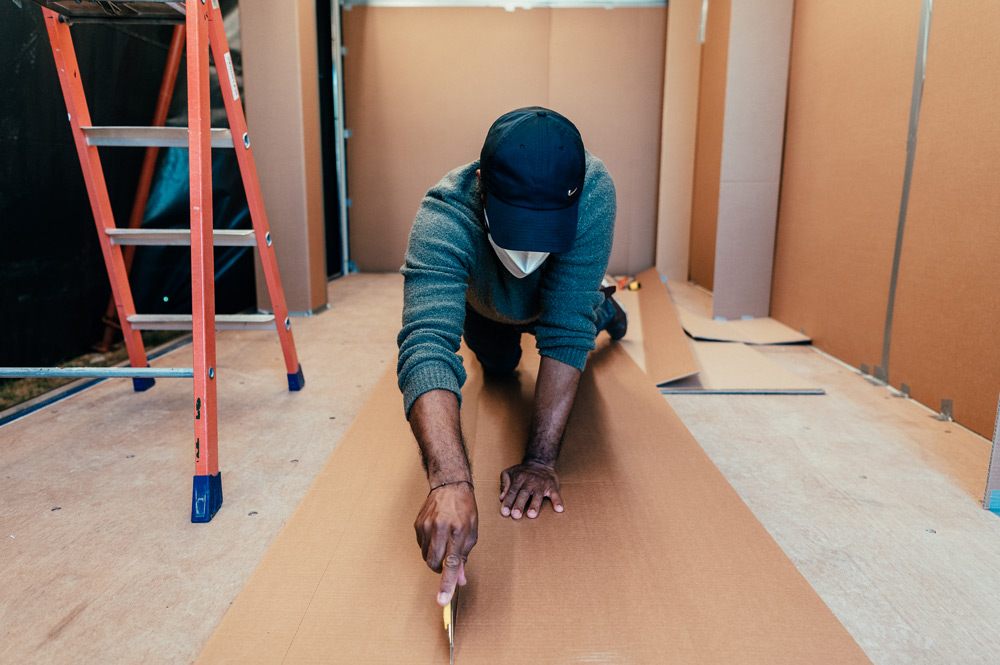‘Home’ by Carlos Bunga
'The body is lost in the uninhabited house of words,
in its cellars, in its endless corridors;
could the body, whatever that may be,
be quiet in the absence of words.'
— Manuel António Pina, ‘Uma casa’ [A house], in Como se desenha uma casa. Lisbon: Assírio & Alvim, 2011, p. 17 (our translation).
In 2011, Manuel António Pina wrote a series of poems on the symbolism of houses. Discussing ‘How to draw a house’, he quickly concluded: ‘with a degree of abstraction and without a rigorous plan.’[1] Developing this idea further, we propose that perhaps what we seek over the course of a life is precisely this: to build a house that protects us, a safe haven, that does not repress or deprive us but rather, in some way, liberates us and gives us autonomy, with a relative detachment and without an intransigent plan.
In his project Home, from 2022, Carlos Bunga indicates and interprets ‘how to draw a house.’ From the very beginning of the project to the placement of the container/house in the public space, the house’s design has been implicit in its conception. The design emerges as a plan and process of creation, from the ‘here and now’, bridging the gap between the work’s origin and its permanence in the public space, seeking the visitor’s active participation.
It is interesting to consider it in relation to Marc Augé’s reading of the term ‘place.’ For Augé, ‘places’ are fundamental because they are relational, historical and concerned with identity. Subjects connect to places and there is a recognition over the course of their life. There is the place one is born, the place one comes from, the place one works, the place one lives[2].
For Carlos Bunga, this place Augé describes is home, in a broad sense: our mother’s womb – the first place we live – student housing or the studio as a refuge; the hotel, the houses of others or friendship as a residence; the people we love.
The construction of a home is more than the house itself, physical and material; it is a ‘tool for a dignified life’[3], Carlos Bunga explains. In other words, home is always also a physical memory.

When Rita Albergaria and I invited Carlos Bunga to produce a work involving the installation of shipping container in a public space in the city of Lisbon, his first thought was to put it on the Tagus River. The container would be on a platform, inaccessible, but visible. Several difficulties led to the subsequent conception of Home, initially installed in the Terreiro do Paço and now in the Gulbenkian Garden, with clearly distinct presences: the first location in an urban space next to the river, where people arrive by boat or where tourists wander about discovering the city; the second in a more protected place, enveloped in the landscape.
This work’s construction process is clearly characteristic of Bunga’s artistic practice. All that Carlos Bunga’s works have in common is an appearance of being handmade, that is, they are all produced by hand, with skill and ingenuity, on a scale determined by his body.
In this container, the person relates curiously with the piece – in a public space, with the constant circulation of passers-by, the home Bunga proposes to us is closed, with a window that lets us take a peek inside, but not enter. There is a confrontation between our body outside and the home inside; the house also maintains an element of mystery, being accessible only to our gaze and not to our bodies. The absence of furniture and other fittings in this site-specific work is intentional: the relationship between body and furniture requires a participation that is absent here.
The use of cardboard in Carlos Bunga’s work has a symbolism that has been analysed previouslyo[4], which involves the packaging and protection of intimacy.

In Home, the use of cardboard, adhesive tape and plastic paint reflects fragility, although the cardboard remains clean and solid; the architecture demonstrates a certain rigidity and resistance.
Fragility remains a constant challenge in Bunga’s work: in his first paintings there is an idea of temporality and ephemerality – the artist did experiments to speed up degradation. After this practice, the artist transferred painting to spatial concepts.
Fragility is also a biographical theme, linked to not being in any one place, in any one house; Carlos Bunga lived as a nomad in ‘shelters.’ There is always a political and social dimension in the life and work of the artist: fragility of human and material existence, escape, migration, expulsion, spaces between, street-interior, building-house, between a container that protects and is simultaneously a space used to move things, nomadic, transformative, art.
[1] Manuel António Pina, ‘Uma casa’ [A house], in Como se desenha uma casa. Lisbon: Assírio & Alvim, 2011, p. 9.
[2] Marc Augé, Non-places. Introduction to an anthropology of supermodernity. Trans. Hohn Howe London, New York: Verso, 1995, p. 77.
[3] Nomad / Carlos Bunga. Lisbon: Documenta / Fundação Carmona e Costa, 2019.
[4] João Fernandes, ‘Arquiteturas de cartão’, in Carlos Bunga. Porto: Fundação de Serralves, 2013.

